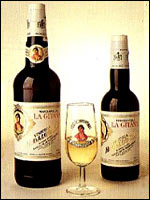|
Oh, Sherry |
||
| Before the warm weather arrives (and with it a desire for margaritas and beer), savor a fiery sherry or a well-aged port. Just be sure to get the right ones... | ||
| April 5, 2002 | ||
|
Winter may have just left us, but it's not too late to enjoy a bottle or three of port and sherry. Slightly fiery, these distinctive Iberian fortified wines are the great warmer-uppers when the weather is still chilly and crisp. Port you're best off storing at home. Sherry, on the other hand, you should always drink fresh, preferably bought the day you intend to open it from off the shelf of a store with a high turnover. Both ports and sherries come in a wide range of styles. First, let's look at sherry, which to my mind remains the greatest bargain in the world of fine wines. Think about it: Ten dollars will get you a first-rate sherry. Twenty to twenty-five an unforgettable bottle. Beat that. A quick primer: Sherries range from bone-dry finos and Manzanillas to medium weight amontillados to the somewhat heavier and sweeter olorosos. At the far extreme of the sweetness scale are the muscatels and P.X.s -- your true heavyweight dessert wines. As for finos, Tio Pepe, from Gonzalez-Byass, remains the yardstick, being both floral and dry. My personal favorite Manzanilla has long been Hidalgo's La Gitana. These are both $10 to $15 wines. Astor Wines in particular offers a fine selection of the Hidalgo sherries. Hidalgo is a strong manufacturer, but if I were to choose the best sherry house of them all it would have to be Emilio Lustau. Even the basics here are invariably superb examples of their kind, beginning with the light, dry, elegant Puerto Fino and its two cousins, the Fino Jarana (slightly fuller to my mind) and the beautiful Manzanilla Papirusa. Ten dollars gets you greatness. Lustau gets the most applause for its Almacenista line. These sherries are held and matured by individual small merchants known as "almacenistas." At this level, every single bottling is of the highest quality: Only personal preference can determine which one is best. My current favorite is the smooth, silky, smoky Oloroso Pata de Gallina 1/38. The 1/38 refers to the fact that the bottle was drawn from one of only 38 casks. Not an Almacenista sherry but equally fine is the Emperatriz Eugenia oloroso. These are $20 to $25 sherries, and all are superb. Unlike sherry, ports, unfortunately, don't come cheap. Indeed, great port is always expensive. At the bottom of the heap are "rubies." For the same $10 you'd spend on a raw, fruity ruby port, I'd much rather drink a good fino sherry. Unless you're using it for cooking, forget the rubies. LBV stands for Late-Bottled Vintage. These are wines of a single vintage, but kept in cask for four years or more. They don't improve with cellaring and are ready to go when opened. The price is right ($15 to $20), but, in general, I'm not wild about LBVs, which don't aspire to all that much. The best of the bunch at the moment -- and, to be fair, these really are good -- are for me the '95 and '96 Fonseca LBVs. The '96 is particularly floral and even elegant -- not a word I usually think of when it comes to LBVs. Tawnies stay a long time in cask -- sometimes a very long time. Ten years is the basic, twenty the first of real interest, thirty perhaps ideal, and forty moving towards the ethereal. As the years pass, these ports become less red and more tawny in color. They also smooth out. My favorite 20 Year Old has to be Graham's, which is incredibly dry and walnutty. Like most first-rate 20 Year Olds, it costs around $40. Among the 30s, I'm wild about the memorable and ever so smooth Taylor's ($80). I'd also put in a word for the rare Portuguese-owned port house, Calem, whose 30 and 40 Year Olds are delicious. For true vintage port, the Duoro region is best known and for good reason. First, as in Champagne, only a few vintages each decade are declared. Second, most of the best port is produced by either of two quality-conscious families, the Robertsons and the Symingtons. The former own the splendid twins Taylor and Fonseca, and have recently added the heretofore laggard Croft and Delaforce. The Symingtons own Warre's, Dow, Graham's, and Smith-Woodhouse. Honestly, you can't go wrong with any of these, though I'd give Alistair Robertson (the chairman and managing director of his namesake house) a few years to turn around the new additions. Of the Robertson and Symington output, the best mature vintages are 1977 and 1985 (both about $100 a bottle). The grandest of all is probably the '94 Taylor, an incomparable wine. Finally, there are the quintas, the individual estate wines. The big boys turn these out in non-declared vintage years. At their best, single quinta wines are all but vintage in quality, and I would certainly recommend the'95 Quinta do Bomfim, the '96 Quinta do Vesuvio, and the '96 Quinta da Foz. My favorites, though, are the 1987, 1991, and 1995 Quinta de Vargellas, all three of which smell of violets. The price range for single quintas is $35 to $60. |
||
| Previous Columns The Best Bubbly Champagne picks in every price range. |
||
|
|
||
